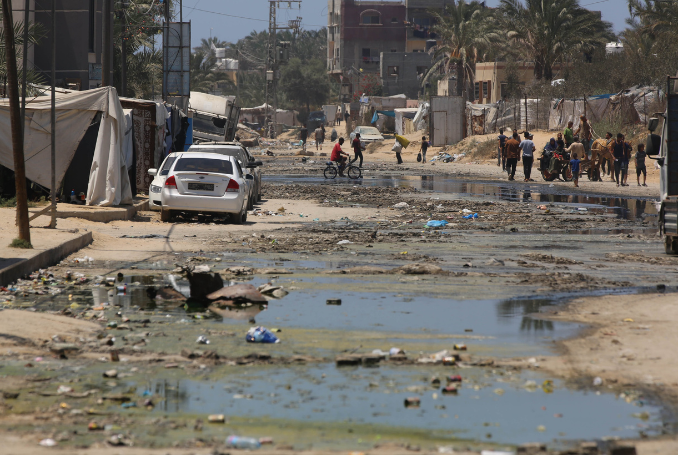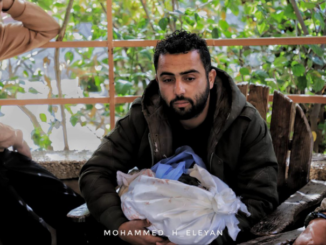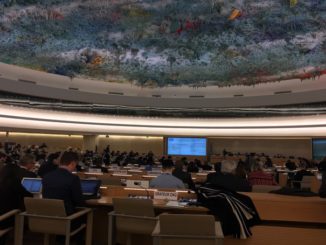
“The problem of waste is pervasive … And though it might not seem like a priority in a conflict zone …this ‘silent threat’ is critical for the public health and the environment people are depending on.”
The accumulation of solid waste in Gaza poses not only “deadly consequences” for its population but could also render the besieged enclave “wholly uninhabitable,” an investigation by the Dutch activist organization PAX has found.
“In unmonitored, make-shift landfills, leaking substances, called leachate, slowly seep into the soil,” the report titled War and Garbage in Gaza warned. “This chemical soup, consisting of soluble organic matter, inorganic components, heavy metals, and xenobiotic organic compounds, contaminates agricultural lands and the aquifer, while eventually toxic substances penetrate the food chain and find their way back to humans.”
Currently, at least 225 large and smaller waste dumps exist across the Gaza Strip according to an analysis of open-source information including satellite imagery, social media posts, and official reports, said PAX.
“The problem of waste is pervasive,” the report said. “And though it might not seem like a priority in a conflict zone, the combination of high temperatures and a destroyed sanitary infrastructure with a population weakened by food insecurity and the lack of medical attention, this ‘silent threat’ is critical for the public health and the environment people are depending on.”
Tons of Solid Waste
It cited the UNRWA report of June 10, 2024, that more than “330,000 tons of solid waste,” enough to fill over 150 football fields, have accumulated in the enclave over the past six months.
This is due to the formal waste collection apparatus having been paralyzed and access to designated landfills blocked by the Israeli army forces.
The PAX investigation found that the collapse of the waste management system has “significantly increased” the public health risks associated with solid waste exposure for tens or even hundreds of thousands of people displaced by the conflict.
Satellite imagery and social media footage reveal that camps for internally displaced people (IDPs) and areas where civilians have sought refuge are situated near large volumes of waste, with small dump sites continually emerging.
PAX cautioned that the “already vulnerable population” is now facing compounded health risks from solid waste.
“This includes the spread of communicable diseases, airborne illnesses caused by deteriorating air quality from waste burning and the odor of decomposing waste, and the exposure of waste-pickers to hazardous medical and industrial waste,” the report stated.
Temporary Dumpsites
Though the waste collection institutional ecosystem suffered from several deficiencies before the current conflict, the damage inflicted upon hundreds of municipal waste collection vehicles, processing facilities, and other tools “deepened the solid waste crisis.”
The closure of the three main landfills by the Israeli army “forced local authorities and UN agencies’ approaches to select local temporary dumpsites.”
“These are often locations in back-alley or empty areas further away from populated areas to minimize civilian exposure,” PAX said.
However, the locations often are not safe landfill sites with protective layers built in and “are likely to contribute to contamination of soil and groundwater from leachate.”
Ceasefire Needed
PAX said “an immediate and permanent ceasefire” is urgently needed to protect the civilian population in the Gaza Strip.
In the absence of a ceasefire, certain actions have to be undertaken to curb the looming health and environmental catastrophe caused by the solid waste management crisis.
These actions include calling on Israel to allow access to the designated safe landfill sites in Gaza.
Environmental Impact of Gaza War ‘Unprecedented’ – United Nations
“Proper disposal of solid waste is currently impossible, which exacerbates the humanitarian crisis by increasing environmental and health risks,” said PAX.
It also includes the provision of “equipment, funding, and training for humanitarian organizations working on clean-up, remediation, and disposal efforts.”
The organization emphasized that the future outlook for Gaza’s ability to cope with numerous challenges—such as rising sea levels, pressure on natural resources (including water), “and the catastrophic level of destruction from the current conflict—will pose an existential challenge for Palestinians.”
Addressing this requires long-term investments and political stability to implement the necessary measures and policies, it said.
Ongoing Genocide
Currently on trial before the International Court of Justice for genocide against Palestinians, Israel has been waging a devastating war on Gaza since October 7.
According to Gaza’s Ministry of Health, 38,848 Palestinians have been killed, and 89,459 wounded. Moreover, at least 11,000 people are unaccounted for, presumed dead under the rubble of their homes throughout the Strip.
Israel says that 1,200 soldiers and civilians were killed during the Al-Aqsa Flood Operation on October 7. Israeli media published reports suggesting that many Israelis were killed on that day by ‘friendly fire’.
Palestinian and international organizations say that the majority of those killed and wounded are women and children.
The Israeli war has resulted in an acute famine, mostly in northern Gaza, resulting in the death of many Palestinians, mostly children.
The Israeli aggression has also resulted in the forceful displacement of nearly two million people from all over the Gaza Strip, with the vast majority of the displaced forced into the densely crowded southern city of Rafah near the border with Egypt – in what has become Palestine’s largest mass exodus since the 1948 Nakba.
Later in the war, hundreds of thousands of Palestinians began moving from the south to central Gaza in a constant search for safety.
(The Palestine Chronicle)








